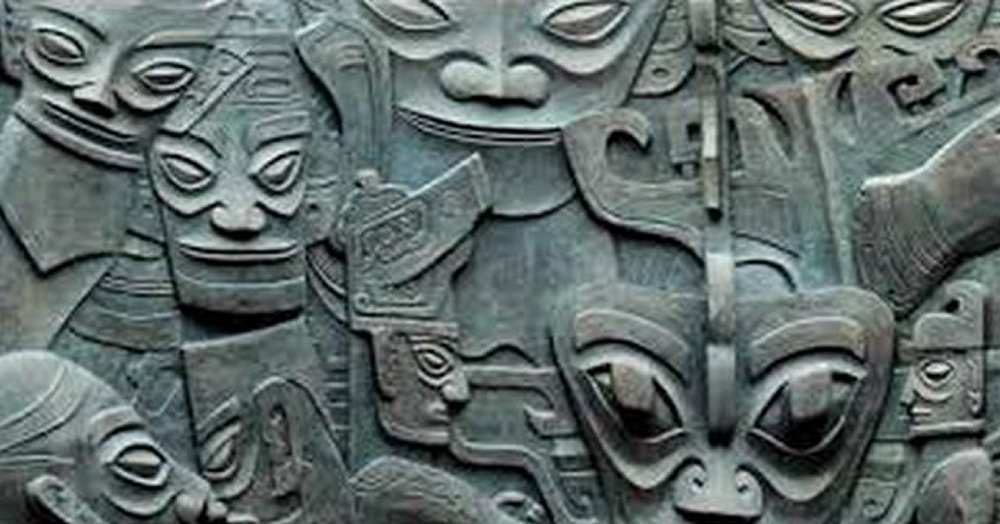A. Sutherland - AncientPages.com - Sanxingdui are ruins of an ancient Chinese city with traces of a previously unknown culture dated to Bronze Age. The ruins are located in the region of Guanghan City, Sichuan Province.
This most remarkable place was first discovered in 1929 when a local farmer accidentally stumbled upon about 400 jade pieces, and these were the first Sanxingdui relics, which were discovered at the site. Since this time, the next generations of archaeologists have excavated and studied the Sanxingdui culture.
In 1986, a team of Chinese archaeologists discovered two major sacrificial pits filled with nearly
1000 bronze objects including hundreds of masks and heads, sun-shaped wares, bronze figures, bells, and a great variety of artworks made in jade, gold and stone. Many pieces of art display decorative dragons, snakes and birds, and other most curious relics that no one has ever seen.
However, no texts that could shed light on the secrets of the Sanxingdui culture were found.
Analysis of lead and other elements in the bronzes indicates sources similar to those of other cultures that lived along the lower reaches of the Yangtze River.
Altogether 120 mysterious Sanxingdui artifacts are dated from the 12th to 11th centuries BC. None of them was found marked with characters or and no historical records of the Sanxingdui culture have been found in the annals of nearby areas.
Among the artifacts, particularly intriguing are the heads (or masks), which do not appear to be human or even animal. They have very sharp features, exceptionally protruding eyes, and exaggerated ears and noses.

Today, it is known that the great legacy of Sanxingdui cannot be entirely associated with the ancient kingdom of Shu, as it was previously thought.
Only a few references regarding the Shu kingdom exist in the early historical records of China until the 4th century BC. The Shu kingdom was subjugated by the state of Qin in 316 BC.
Bronze head (138 cm bred) with protruding eyes believed to be a depiction of Cancong, the semi-legendary first king of Shu. Image credit: Wikipedia
The mysterious Sanxingdui existed in this region much earlier, which was confirmed by recent archaeological excavations. But still, many archaeologists suggested the Sanxingdui culture to be part of the ancient kingdom of Shu.
Who were the people of Sanxingdui civilization? Where did they come from?
See also:
Dazu Rock Statues Of Clairvoyance And Clairaudience
Remarkable 2,000-Year-Old Smoke-Absorbing Lamps Reducing Pollution Discovered
Chang Woo Gow – The Kind And Intelligent Chinese Giant
According to the "Chronicles of Huayang" dated to the Jin Dynasty (265-420), the Shu kingdom was founded by Cancong. Cancong was described as having protruding eyes, a feature that is found in the figures of Sanxingdui. Other eye-shaped objects were also found which might suggest worship of the eyes.
Ancient Chinese myth says that Cancong was the mythical founder of the ancient Shu kingdom and the first ancestor of Shu kings. He taught techniques of silk production. His name means: Can – “silkworm” and cong means: “cluster”.
His appearance was strange, his eyes, for example, bulged in an upright position, which demonstrated his extraordinary powers. He was always seen in green clothes so he was called “Green God” or “God in Green Clothes”.
Written by - A. Sutherland - AncientPages.com Senior Staff Writer
Copyright © AncientPages.com All rights reserved. This material may not be published, broadcast, rewritten or redistributed in whole or part without the express written permission of AncientPages.com
Expand for referencesReferences:
A. P. Underhill, A Companion to Chinese Archaeology
L. Yang, Handbook of Chinese Mythology
Spara
Spara
Spara
Spara
Spara
Spara
Spara
Spara
Spara
Spara
Spara
Spara
Spara
Spara
Spara
Spara
Spara







